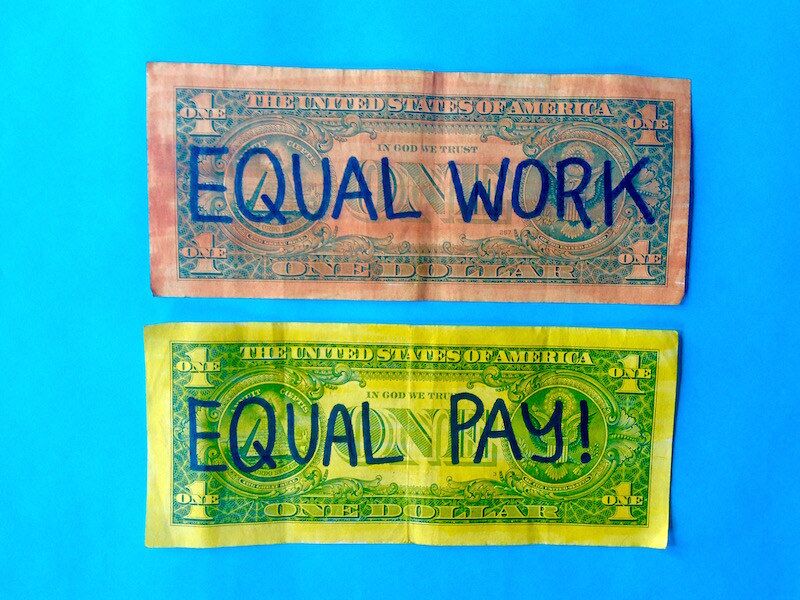If Equal Pay Day was based on a more comprehensive measure of the gendered earnings gap, the day would fall much later in the year—more like October. And for women of color, you’d have to wait until the next year.

Have you ever seen an Equal Pay Day bake sale? That’s when feminists sell baked goods priced according to the gendered wage gap: Men pay a dollar for a cookies or brownies, and women get them for about 80 cents. The prices reflect the gendered wage gap that women on average experience in the U.S. labor force.
Originated by the National Committee on Pay Equity in 1996 and commemorated around the world, Equal Pay Day symbolizes about how far into the year the average woman must work in order to earn what the average man earns in the previous year.
In 2022, Equal Pay Day falls on March 15. Based on census data on median wages for full-time, year-round workers, women now earn 83 cents in salary for every dollar earned by men. But women of color earn even less, according to recent data from Equal Rights Advocates, who calculate that for each $1 a white man earns:
- Asian American, Native Hawaiian and Pacific Islander (AAPI) women earn 75 cents. In 2022, their Equal Pay Day is May 3.
- Black women earn 58 cents. Their Equal Pay Day is September 21, 2022.
- Native American women earn 50 cents, marking Equal Pay Day on December 1.
- Latinas earn 49 cents, and their Equal Pay Day is December 8—almost a whole calendar year behind their counterparts.
The problem with these figures is that the wage gap only includes wages. But earnings include a lot more than just wages. Other forms of compensation must be calculated in earnings—such as health insurance, retirement account contributions, bonuses and self-employment income.
Once you factor in these other forms of earnings, men actually earn 75 percent more than women, according to the Stanford Center on Poverty and Inequality—meaning that women on average earn only 57 cents on a man’s dollar. A study by the Institute for Women’s Policy Research found an even greater gap when measuring total earnings, with women workers earning a mere 49 percent—less than half—of men’s earnings.
If Equal Pay Day was based on this more comprehensive measure of the gendered earnings gap, the day would fall much later in the year—more like October. And for women of color, you’d have to wait until the next year!
If women’s earnings were equal to men’s, poverty for working women would be reduced by half and the U.S. economy would add $482 billion to its economy—2.8 percent of the 2014 GDP.
As women age, the income gap persists. Women are less likely to have pensions than men and they receive less social security on average than men—particularly poor women and women of color—in part because women’s care-giving labor for children, the elderly and ill family members is usually unpaid and given zero value in calculating Social Security payments. In 2017, the average annual Social Security income received by women 65 years and older was $14,353—compared to $18,041 for men. As a result, women are 80 percent more likely than men to be impoverished at age 65 and older.
Three years into a pandemic, it’s clear COVID-19 has amplified existing inequalities, as women took on more unpaid caregiving labor for children and ill family members and low-wage workers, who are disproportionately women, are hit the hardest.
Biden Administration Announces Equal Pay Initiatives
The White House on Tuesday announced new initiatives aimed at closing the gender wage gap within the federal workforce. The Office of Personnel Management announced a ban on salary history inquiries, which carry over discriminatory pay practices from job to job. An executive order from Biden encourages federal contractors—who make up a meaningful share of U.S. employers—to do the same.
“For years, salary histories have been used when making hiring decisions and determining pay rates,” said Jocelyn C. Frye, president of the National Partnership for Women and Families. “This is yet another practice that has worked to keep women connected to their prior, often lower wages. As a result, even when women seek out new employment, a discriminatory prior wage can effectively follow them from job to job because their employer limits how much they can earn based on their prior salary. And that limits their earning potential over the course of their careers. It is critical to eliminate these types of practices to ensure that women of color, and indeed all women, earn fair wages for the jobs that they perform.”
Take Action for Equal Pay
- Speak out on social media at #EqualPayDay, #BlackWomensEqualPayDay, #NativeWomensEqualPayDay, #AAPIEqualPayDay, and #LatinaEqualPayDay to raise awareness about the true earnings gap—that women on average earn about half of what men make—and demand change.
- Send a pre-drafted email to your congressional representatives with a few clicks. The Paycheck Fairness Act will help end pay discrimination for women and people of color. Let’s get Congress to pass this bill so we can make sure women—especially women of color—are paid what they’re owed.
Up next:

